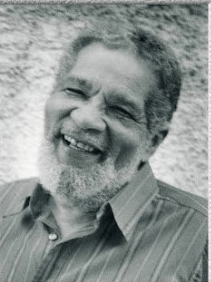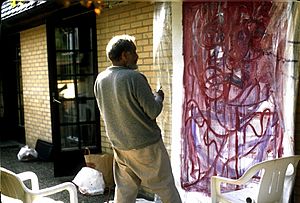Herbert Gentry facts for kids
Quick facts for kids
Herbert Gentry
|
|
|---|---|
 |
|
| Born | July 17, 1919 Pittsburgh, Pennsylvania
|
| Died | September 8, 2003 Stockholm, Sweden
|
| Nationality | U.S. citizen |
| Occupation | Artist, Painter |
Herbert Alexander Gentry (born July 17, 1919 – died September 8, 2003) was an African-American painter. He was known for his Expressionist art style. Gentry lived and worked in many exciting cities around the world. These included Paris, France; Copenhagen, Denmark; Stockholm, Sweden; Malmö, Sweden; and New York City in the USA.
Contents
Herbert Gentry's Art Style
Herbert Gentry's paintings often show faces and masks. He liked to change how figures and heads—both human and animal—were placed on the canvas. They might be looking left, right, up, or down. He played with the size and position of each head, and how they related to each other.
His art was not about telling a clear story. Instead, Gentry used his paintings to show his feelings and experiences. He painted in a spontaneous way, meaning he let his feelings guide his brush. Each painting was a way for him to express himself.
Gentry's art was like jazz music. It had rhythm and energy. Art expert Peter Selz said Gentry's paintings mixed the quick beats of jazz with shapes that looked like living things. His art was never fully abstract, but it used ideas from Cubism. This means he broke down figures into different shapes and angles. Another artist, Romare Bearden, noted that Gentry's art came from his feelings and his unconscious mind.
Herbert Gentry's Life Story
Growing Up in the Harlem Renaissance
Herbert Alexander Gentry was born in Pittsburgh, Pennsylvania, on July 17, 1919. His mother, Violet Howden, was from Kingston, Jamaica. His father was James Jentry. By 1924, Herbert was living in Harlem, New York City, with his mother and her family.
His childhood happened during the Harlem Renaissance. This was a time when African-American art, music, and literature really blossomed in Harlem. Herbert's mother, Teresa Gentry, was a dancer and actress. She performed with famous artists like Josephine Baker. She was also in the original Broadway show Show Boat. Herbert's mother was friends with many famous people, including writer Langston Hughes and musician Duke Ellington.
As a young boy, Gentry even acted in a play called Scarlet Sister Mary on Broadway. He was inspired by all the artists, musicians, and writers around him. This made him believe in the power of creativity.
Herbert went to public schools in New York City. He loved drawing and took art classes at the Harlem YMCA. He also studied art as part of a government program called the Federal Art Project. Later, he studied business at New York University. He was one of the first Black employees in a white-collar job at Consolidated Edison.
Gentry served in the U.S. Army from 1942 to 1945 during World War II. He traveled to many countries, including Morocco, Algeria, Italy, and France. He loved visiting Paris whenever he could.
Living as an Artist Abroad
Paris: The Early Years (1946–1958)
After the war, Gentry wanted to study art in Paris. Many of his mother's friends had talked about their time there. He arrived in Paris in 1946. He studied French and art at famous schools like the Académie de la Grande Chaumière. By 1949, he was even teaching art there and had his first art show in Paris.
Gentry loved the lively café life in Montparnasse. He met many American artists there, including sculptors and painters. He also met famous artists like Alberto Giacometti and Georges Braque.
Between 1948 and 1951, Gentry opened his own club called Chez Honey. It was an art gallery during the day and a jazz club at night. His first wife, Honey Johnson, was a singer there. The club became famous for its modern jazz music. Many well-known people visited, including writers Jean-Paul Sartre and Simone de Beauvoir, and actress Eartha Kitt.
After a short time back in New York, Gentry returned to Paris in 1953. He worked in jazz clubs and arranged shows for American soldiers. He met more famous people like writer Maya Angelou. He even studied art privately with the great painter Georges Braque. Gentry also met artists from the COBRA art group, who were from Denmark, Belgium, and the Netherlands.
Copenhagen: A Jazz and Art Hub (1958–1962)
In 1959, Gentry moved to Copenhagen, Denmark, for an art exhibition. Copenhagen was a big jazz city in Europe. After his successful show, he stayed there to prepare for more exhibitions across Northern Europe. His paintings were shown in galleries in Denmark, Sweden, Switzerland, and the Netherlands. Critics said his work was unique and American, even though it had some similarities to the COBRA art movement.
Stockholm: Exhibitions and Recognition (1963–1976)
Gentry moved to Gothenburg, Sweden in 1963, and then to Stockholm by 1965. He made friends with Swedish artists. He had important art shows, including one at the Royal Swedish Academy of Arts in Stockholm in 1975. This was a special exhibition that looked back at his career. It also traveled to museums in other cities.
Even while living in Scandinavia, Gentry kept an art studio in Paris. He liked to move around, just like other international artists who had studios in different countries. Paris remained an important center for the art world.
Paris: A Return (1976–1980)
Gentry was given a studio at the Cité internationale des arts in Paris for four years. During this time, he tried new art techniques, like painting with acrylics on raw linen. He made new artist friends and had solo exhibitions in the United States and Sweden.
Malmö: Later Years in Sweden (1980–2003)
In his later years, Gentry spent more time in New York City. He then returned to Sweden and set up his studio in Malmö. He liked Malmö's calm atmosphere and its location near Copenhagen. He reconnected with old friends and prepared paintings and prints for shows in Sweden and other European cities like Milan and Amsterdam. He had many solo exhibitions in Europe and Scandinavia during this time.
Back Home in New York (1969–2003)
In 1971, the director of the Moderna Museet suggested that Gentry and his family stay at the Hotel Chelsea in New York City. This hotel was a famous place for artists. Gentry found many artist friends from Paris already living there. Having a home in New York allowed Gentry to return often and be active in the New York art scene. He had exhibitions at galleries and museums there. He became a "permanent resident" of the Chelsea Hotel in 1982. He reconnected with old artist friends like Romare Bearden and made new ones.
Between 1975 and 1995, Gentry traveled a lot. He went back and forth between New York and Paris or Sweden several times a year. He became well-known in the United States. In Europe, he was shown as an American artist. In the United States, he was shown as an African-American artist.
Starting in 1987, Gentry had many solo exhibitions in the United States. These included shows in Los Angeles, New Orleans, and New York. He also had nine solo shows at the G. R. N’Namdi Gallery in various cities.
Two important exhibitions were held at the Studio Museum in Harlem: "An Ocean Apart" in 1982, and "Explorations in the City of Light" in 1996. The "Explorations" show traveled to several other museums across the country.
After Gentry passed away in 2003, many special exhibitions honored his work. These included "Herbert Gentry: Moved by Music" at the Wadsworth Atheneum in 2006, and "Herbert Gentry: the Man the Magic the Master" at Morgan State University in 2007.
Where to See Herbert Gentry's Art
Herbert Gentry's art can be found in many important collections around the world.
In the United States, his work is in:
- The Metropolitan Museum of Art (New York)
- The American Art Museum and Hirshhorn Museum (Smithsonian, Washington, D.C.)
- The Studio Museum in Harlem (New York)
- The Masur Museum (Monroe, Louisiana)
- The Wadsworth Atheneum Museum of Art (Hartford, Connecticut)
- The Dayton Art Institute (Dayton, Ohio)
- The Brooklyn Museum (Brooklyn, New York)
In Europe and beyond, his art is in:
- The Moderna Museet (Stockholm, Sweden)
- Norrköpings Art Museum (Norrköping, Sweden)
- Stedelijk Museum (Amsterdam, Netherlands)
- National Gallery of Modern Art (New Delhi, India)
- Bibliothèque Nationale de Paris (France)
His art is also held in many private collections.
See also


